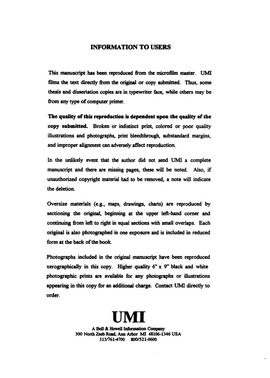| dc.contributor.advisor | Weaver, Barry, | en_US |
| dc.contributor.author | Kar, Adityamoy. | en_US |
| dc.date.accessioned | 2013-08-16T12:29:50Z | |
| dc.date.available | 2013-08-16T12:29:50Z | |
| dc.date.issued | 1997 | en_US |
| dc.identifier.uri | https://hdl.handle.net/11244/5526 | |
| dc.description.abstract | The mafic rocks (basalt-hawaiite-mugearite-benmoreite) of Ascension Island form four distinct groups: low Zr/Nb hawaiite, high Zr/Nb basalt, intermediate Zr/Nb basalt to benmoreite, and Dark Slope Crater (DSC) hawaiite and mugearite. | en_US |
| dc.description.abstract | The geochemical characteristics of the felsic rocks are largely consistent with an origin by fractional crystallization of high Zr/Nb mafic magmas (identical $\rm\sp{143}Nd/\sp{144}Nd$ and similar Pb isotopic ratios). Syenite, monzonite, and granite xenoliths are cumulate rocks from, and intrusive equivalents of, fractionating felsic magmas. Internal (mineral) isochrons for two granite xenoliths give ages of $\sim$1.0 Ma. Most of the felsic volcanic rocks and granite are also characterized by high $\rm\spƠS̜r/\spƠ$̜Sr ($>$0.706) compared to mafic rocks $\rm(\spƠS̜r/\spƠS̜r}0.704)$ in some of the feldspar phenocrysts from felsic rocks. d$\spÔΩ̜$O ranges of +5.5 to +8.1$\perthous$ (whole rock) and +5.5 to +7.2$\perthous$ (feldspar) in the felsic rocks also indicate the involvement of a high d$\spÔΩ̜$O component, and suggest that hydrothermally-altered pre-existing volcanic basement may have been cannibalized during felsic magma differentiation. | en_US |
| dc.description.abstract | Crystal fractionation controls compositional variation within each mafic group, however, it cannot be the cause of the differences between the groups. The high and intermediate Zr/Nb groups have similar Sr-Nd-Pb isotopic characteristics and were derived from the same mantle source (HIMU-type). The low Zr/Nb and DSC groups have different radiogenic isotopic characteristics due to contributions from enriched mantle components (HIMU-type). The dominant component, present in the high, intermediate, and low Zr/Nb groups, has the composition of the St. Helena hotspot and has mixed to varying degrees with the depleted upper mantle. The more minor component, present only in the DSC group and some intermediate Zr/Nb samples, has higher $\rm\sp{208}Pb/\sp{204}Pb$ relative to $\rm\sp{208}Pb/\sp{204}Pb$ than the St. Helena hotspot. This component may be of local lithospheric origin. | en_US |
| dc.format.extent | 1 v. (various pagings) : | en_US |
| dc.subject | Geology. | en_US |
| dc.subject | Basalt Ascension Island (Atlantic Ocean) | en_US |
| dc.subject | Geochemistry Ascension Island (Atlantic Ocean) | en_US |
| dc.subject | Petrogenesis Ascension Island (Atlantic Ocean) | en_US |
| dc.subject | Rhyolite Ascension Island (Atlantic Ocean) | en_US |
| dc.subject | Geochemistry. | en_US |
| dc.title | A comprehensive geological, geochemical, and petrogenetic study of hotspot-related oceanic basalt-rhyolite series rocks from Ascension Island, South Atlantic Ocean. | en_US |
| dc.type | Thesis | en_US |
| dc.thesis.degree | Ph.D. | en_US |
| dc.thesis.degreeDiscipline | Conoco Phillips School of Geology and Geophysics | en_US |
| dc.note | Source: Dissertation Abstracts International, Volume: 58-08, Section: B, page: 4102. | en_US |
| dc.note | Major Professor: Barry Weaver. | en_US |
| ou.identifier | (UMI)AAI9806319 | en_US |
| ou.group | Mewbourne College of Earth and Energy::Conoco Phillips School of Geology and Geophysics | |
